The Effects of Climate Change on Pine Wilt Disease in South Korea: Challenges and Prospects
Abstract
1. Introduction
1.1. Research Background
1.2. Impacts of Climate on Pine Wilt Disease Infestation
2. Materials and Methods
2.1. Damage Function
2.2. Empirical Model and Data
2.3. Estimation Method
2.4. Projections of Pine Wilt Disease under Climate Change
2.5. Economic Evaluation of Pine Wilt Disease
3. Results
3.1. Estimation Results
3.2. Projection Results
3.3. Results of the Economic Analysis
3.4. Simulation
3.4.1. Changes in the Market Price of Timber
3.4.2. Changes in Green Payments
3.4.3. Climate Change
4. Discussion
5. Conclusions
Author Contributions
Funding
Acknowledgments
Conflicts of Interest
Appendix A
| Year | Spring temperature | Summer temperature | Fall temperature | Winter temperature |
| 2009–2017 | 11.22 | 23.92 | 13.95 | -0.25 |
| 2018–2050 | 12.34 | 25.03 | 15.23 | 1.15 |
| 2051–2070 | 13.72 | 26.53 | 26.72 | 2.90 |
| 2071–2100 | 15.44 | 28.40 | 18.83 | 4.68 |
| Year | Spring precipitation | Summer precipitation | Fall precipitation | Winter precipitation |
| 2009–2017 | 115.90 | 304.52 | 88.02 | 32.54 |
| 2018–2050 | 113.83 | 314.95 | 93.94 | 44.96 |
| 2051–2070 | 115.13 | 356.44 | 104.68 | 48.07 |
| 2071–2100 | 130.06 | 327.77 | 94.27 | 61.25 |
| Unit | Gangwon Pine | Central Pine | Korea Pine | |
|---|---|---|---|---|
| Timber market price | 1000 KRW/m3 | 109.1 | 109.1 | 89.1 |
| Afforestation costs | 1000 KRW/ha | 7415 | 7415 | 6066 |
| Logging costs | 1000 KRW/ha | 16,109 | 16,109 | 16,109 |
| Green payments | 1000 KRW/ha | 100 | 100 | 100 |
| Discount rates | % | 3 | 3 | 3 |
| p | 0.00054 × L | 0.00054 × L | 0.00054 × L | |
| δ | 0.002 | 0.002 | 0.002 | |
| 0 | 0 | 0 | ||
| σ | 0 | 0 | 0 | |
| Control and prevention costs | 1000 KRW/ha | 900 | 900 | 900 |
| Handling costs for dead tree | 1000 KRW/ha | 3500 | 3500 | 3500 |
| Land area (L) | ha | 100 | 100 | 100 |
References
- National Institute of Forest Science. Annual Report of Monitoring for Forest Insect Pests and Diseases in Korea; National Institute of Forest Science: Seoul, Korea, 2017; ISBN 9791160191004. [Google Scholar]
- Vicente, C.; Espada, M.; Vieira, P.; Mota, M. Pine Wilt Disease: A threat to European forestry. Eur. J. Plant Pathol. 2012, 133, 89–99. [Google Scholar] [CrossRef]
- Kuroda, K. Physiological Incidences Related to Symptom Development and Wilting Mechanism. In Pine Wilt Disease; Zhao, B.G., Futai, K., Sutherland, J.R., Takeuchi, Y., Eds.; Springer: Tokyo, Japan, 2008; pp. 204–222. ISBN 978-4-431-75655-2. [Google Scholar]
- Korea Forest Service. Guideline for the Prevention of Pine Wilt Disease; Korea Forest Service: Daejeon, Korea, 2017. [Google Scholar]
- Cobourn, K.M.; Burrack, H.J.; Goodhue, R.E.; Williams, J.C.; Zalom, F.G. Implications of simultaneity in a physical damage function. J. Environ. Econ. Manag. 2011, 62, 278–289. [Google Scholar] [CrossRef]
- Mundlak, Y. On the Pooling of Time Series and Cross Section Data. Econometrica 1978, 46, 69–85. [Google Scholar] [CrossRef]
- Chamberlain, G. Analysis of Covariance with Qualitative Data. Rev. Econ. Stud. 1980, 47, 225–238. [Google Scholar] [CrossRef]
- Dietrich-Egensteiner, W. A Beginner’s Guide to the IPCC Climate Change Reports. Available online: https://www.popularmechanics.com/science/environment/climate-change/a-beginners-guide-to-the-ipcc-climate-change-reports-15991849 (accessed on 16 May 2019).
- Riahi, K.; Rao, S.; Krey, V.; Cho, C.; Chirkov, V.; Fischer, G.; Kindermann, G.; Nakicenovic, N.; Rafaj, P. RCP 8.5—A scenario of comparatively high greenhouse gas emissions. Clim. Change 2011, 109, 33. [Google Scholar] [CrossRef]
- Linit, M.J. Nemtaode-Vector Relationships in the Pine Wilt Disease System. J. Nematol. 1988, 20, 227–235. [Google Scholar] [PubMed]
- Zhao, B.G. Pine Wilt Disease in China. In Pine Wilt Disease; Zhao, B.G., Futai, K., Sutherland, J.R., Takeuchi, Y., Eds.; Springer: Tokyo, Japan, 2008; pp. 18–25. ISBN 978-4-431-75655-2. [Google Scholar]
- Togashi, K. Nematode-Vector Beetle Relation and the Regulatory Mechanism of Vector’s Life History in Pine Wilt Disease. Formosan Entomologist 2013, 33, 189–205. [Google Scholar]
- Panesar, T.S.; Peet, F.G.; Sutherland, J.R.; Sahota, T.S. Effects of temperature, relative humidity and time on survival of pinewood nematodes in wood chips. Eur. J. For. Pathol. 1994, 24, 287–299. [Google Scholar] [CrossRef]
- Bentz, B.J.; Régnière, J.; Fettig, C.J.; Hansen, E.M.; Hayes, J.L.; Hicke, J.A.; Kelsey, R.G.; Negrón, J.F.; Seybold, S.J. Climate Change and Bark Beetles of the Western United States and Canada: Direct and Indirect Effects. BioScience 2010, 60, 602–613. [Google Scholar] [CrossRef]
- Roques, A.; Zhao, L.; Sun, J.; Robinet, C. Pine wood nematode, pine wilt disease, vector beetle and pine tree: How a multiplayer system could reply to climate change. In Climate Change and Insect Pests; Björkman, C., Niemelä, P., Eds.; CABI Publishing: Oxfordshire, UK, 2015; pp. 220–234. ISBN 9781780643786. [Google Scholar]
- Togashi, K.; Chung, Y.-J.; Shibata, E. Spread of An Introduced Tree Pest Organism–The Pinewood Nematode; Hong, S.-K., Lee, J.A., Ihm, B.-S., Farina, A., Son, Y., Kim, E.-S., Choe, J.C., Eds.; Ecological Issues in a Changing World; Springer: Dordrecht, The Netherlands, 2004; pp. 173–188. [Google Scholar]
- Naves, P.; de Sousa, E. Threshold temperatures and degree-day estimates for development of post-dormancy larvae of Monochamus galloprovincialis (Coleoptera: Cerambycidae). J. Pest Sci. 2009, 82, 1–6. [Google Scholar] [CrossRef]
- Weina, K. The effects of temperature and humidity on the longevity of Monochamus alternatus Hope (Coleoptera Cerambycidae). J. Shanxi Agric. Univ. 2006, 26, 294–295. [Google Scholar]
- Evans, S.; Evans, H.; Ikegami, M. Modeling PWN-Induced Wilt Expression: A MechanisticApproach. In Pine Wilt Disease: A Worldwide Threat to Forest Ecosystems; Mota, M.M., Vieira, P., Eds.; Springer: Dordrecht, The Netherlands, 2008; pp. 259–278. ISBN 978-1-4020-8455-3. [Google Scholar]
- Robinet, C.; Roques, A.; Pan, H.; Fang, G.; Ye, J.; Zhang, Y.; Sun, J. Role of Human-Mediated Dispersal in the Spread of the Pinewood Nematode in China. PLoS ONE 2009, 4, e4646. [Google Scholar] [CrossRef] [PubMed]
- Nakamura, K.; Maehara, N.; Aikawa, T.; Ichihara, Y.; Kosaka, H.; Kanzaki, N.; Kagaya, E.; Sugita, H.; Masaki, T.; Kimura, K.; et al. A Research Project to Develop Strategic Action Plan in the Pine-Wilt-Disease Unaffected Area in Northern Japan. In Pine Wilt Disease Conference 2013; Schröder, T., Ed.; Berichte aus dem Julius Kühn-Institut: Braunschweig, Germany, 2013; p. 66. [Google Scholar]
- Shinya, R.; Morisaka, H.; Takeuchi, Y.; Futai, K.; Ueda, M. Making headway in understanding pine wilt disease: What do we perceive in the postgenomic era? J. Biosci. Bioeng. 2013, 116, 1–8. [Google Scholar] [CrossRef]
- Kim, J.W.; Junf, H.C.; Park, Y.H. Predicting Potential Distribution of Monochamus alternatus Hope responding to Climate Change in Korea. Korean J. Appl. Entomol. 2016, 55, 501–511. [Google Scholar] [CrossRef]
- Neuvonen, S.; Virtanen, T. Abiotic factors, climatic variability and forest insect pests. In Climate Change and Insect Pests; Björkman, C., Niemelä, P., Eds.; CABI: Wallingford, UK, 2015; pp. 154–172. ISBN 978-1-78064-378-6. [Google Scholar]
- Ma, R.-Y.; Hao, S.-G.; Kong, W.-N.; Sun, J.-H.; Kang, L. Cold hardiness as a factor for assessing the potential distribution of the Japanese pine sawyer Monochamus alternatus (Coleoptera: Cerambycidae) in China. Ann. For. Sci. 2006, 63, 449–456. [Google Scholar] [CrossRef][Green Version]
- Kobayashi, F.; Yamane, A.; Ikeda, T. The Japanese Pine Sawyer Beetle as the Vector of Pine Wilt Disease. Annu. Rev. Entomol. 1984, 29, 115–135. [Google Scholar] [CrossRef]
- Okuda, M. Development and Growth of Pine Sawyer Larvae Under Different Temperature Conditions. In Trans. 24th Annual Meeting, Kansai Branch; Japanese Forest Society: Tokyo, Japan, 1973; pp. 146–149. [Google Scholar]
- Enda, N. Period from Pupation to Emergence of the Pine Sawyer. In Trans. 32th Annual Meeting, Kanto Branch; Japanese Forest Society: Tokyo, Japan, 1973; pp. 91–92. [Google Scholar]
- Rutherford, T.A.; Webster, J.M. Distribution of pine wilt disease with respect to temperature in North America, Japan, and Europe. Can. J. For. Res. 1987, 17, 1050–1059. [Google Scholar] [CrossRef]
- Mamiya, Y. The life history of the pine wood nematode, Bursaphelenchus lignicolus. Jpn. J. Nematol. 1975, 5, 16–25. [Google Scholar]
- Papke, L.E.; Wooldridge, J.M. Econometric methods for fractional response variables with an application to 401(k) plan participation rates. J. Appl. Econom. 1996, 11, 619–632. [Google Scholar] [CrossRef]
- Papke, L.E.; Wooldridge, J.M. Panel data methods for fractional response variables with an application to test pass rates. J. Econom. 2008, 145, 121–133. [Google Scholar] [CrossRef]
- Macpherson, M.F.; Kleczkowski, A.; Healey, J.R.; Hanley, N. Payment for multiple forest benefits alters the effect of tree disease on optimal forest rotation length. Ecol. Econ. 2017, 134, 82–94. [Google Scholar] [CrossRef] [PubMed]
- Macpherson, M.F.; Kleczkowski, A.; Healey, J.R.; Hanley, N. The Effects of Disease on Optimal Forest Rotation: A Generalisable Analytical Framework. Environ. Resour. Econ. 2018, 70, 565–588. [Google Scholar] [CrossRef] [PubMed]
- National Institute of Forest Science. Timber Resources, Biomass and Standing Forest; Korea Forest Service: Daejeon, Korea, 2012; ISBN 978-89-8176-875-1. [Google Scholar]
- Min, K.; Seok, H.; Choi, J. Policy Tasks to Improve the Profitability of Forest Management in Korea; Korea Rural Economic Institute: Seoul, Korea, 2017. [Google Scholar]
- Togashi, H.; Takahashi, K.; Makihara, H. Oviposition of Monochamus Alternatus on Pinus Desiflora and P.Thunbergii Trees Felled Doan at Different Occasions. In Trans. 104th Annual Meeting; Japanese Forest Society: Tokyo, Japan, 1993; pp. 665–666. [Google Scholar]
- Danks, H.V. Insect Dormancy: An Ecological Perspective; Insect Dormancy Ecol; Key Perspective: Truro, UK, 1987. [Google Scholar]
- Togashi, K. Interacting Effects of Temperature and Photoperiod on Diapause in Larvae of Monochamus alternatus (Coleoptera: Cerambycidae). Jpn. J. Entomol. 1995, 63, 243–252. [Google Scholar]
- Robinet, C.; Van Opstal, N.; Baker, R.; Roques, A. Applying a spread model to identify the entry points from which the pine wood nematode, the vector of pine wilt disease, would spread most rapidly across Europe. Biol. Invasions 2011, 13, 2981–2995. [Google Scholar] [CrossRef]
- Gan, J. Risk and Damage of Southern Pine Beetle Outbreaks Under Global Climate Change. For. Ecol. Manag. 2004, 191, 61–71. [Google Scholar] [CrossRef]
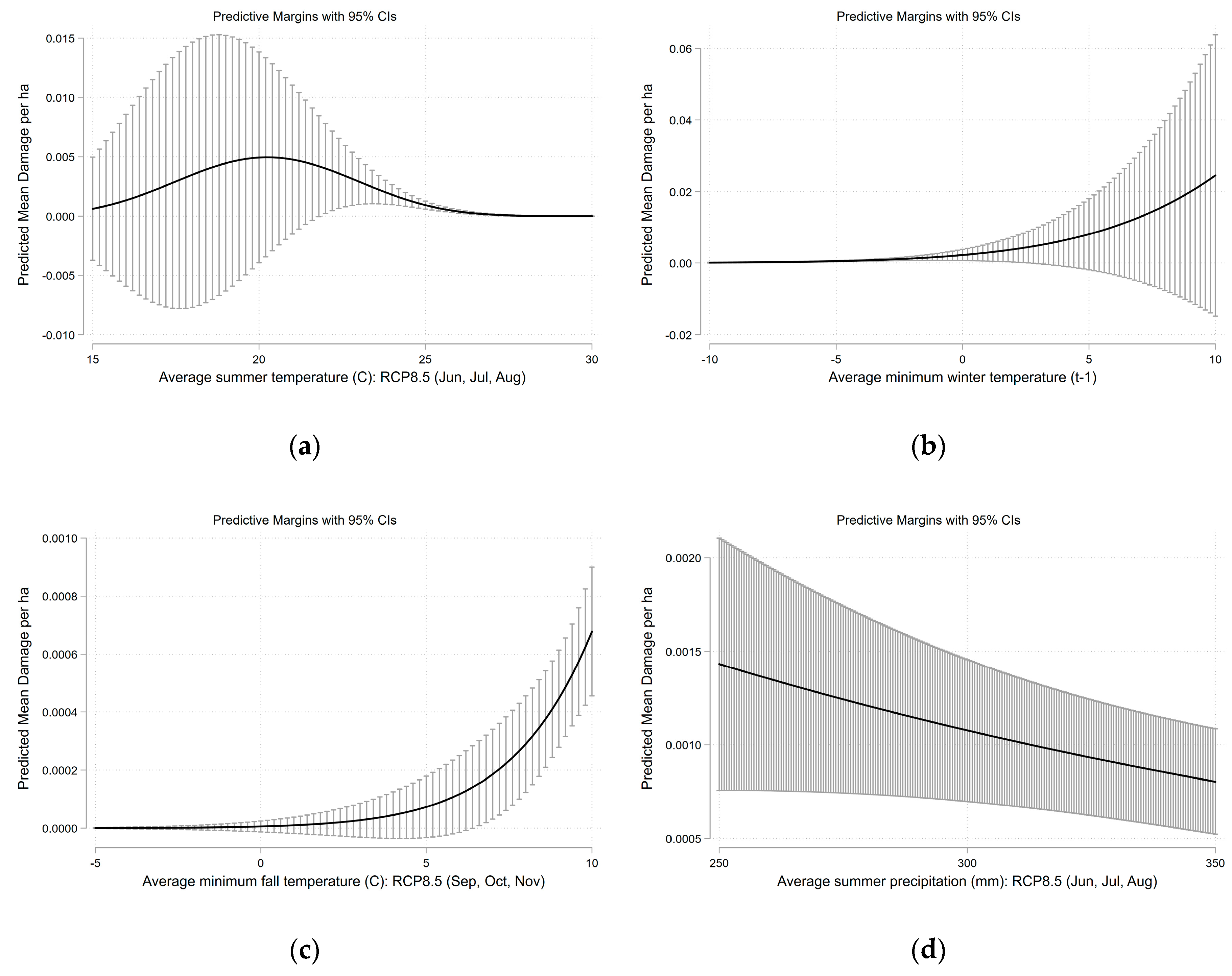
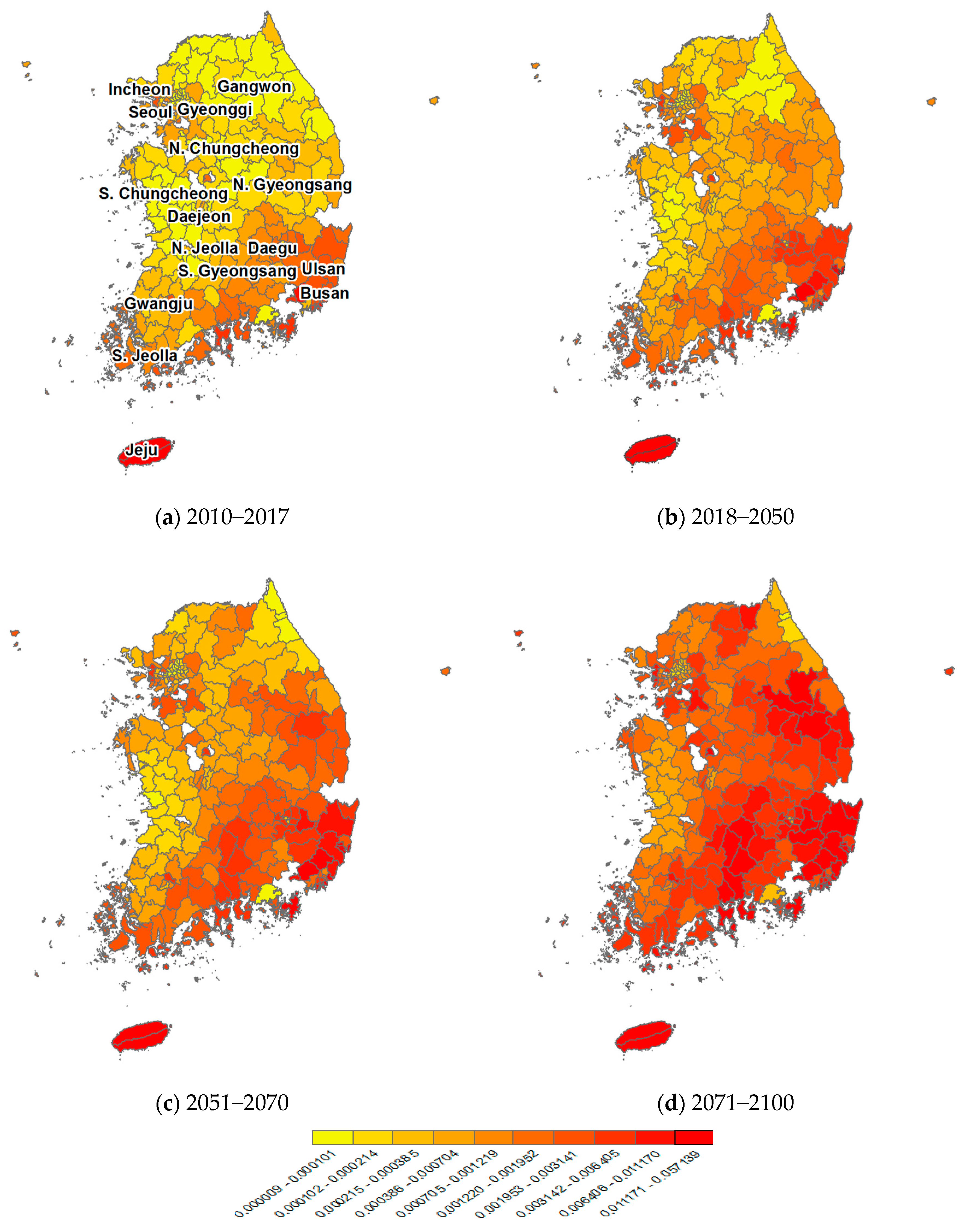
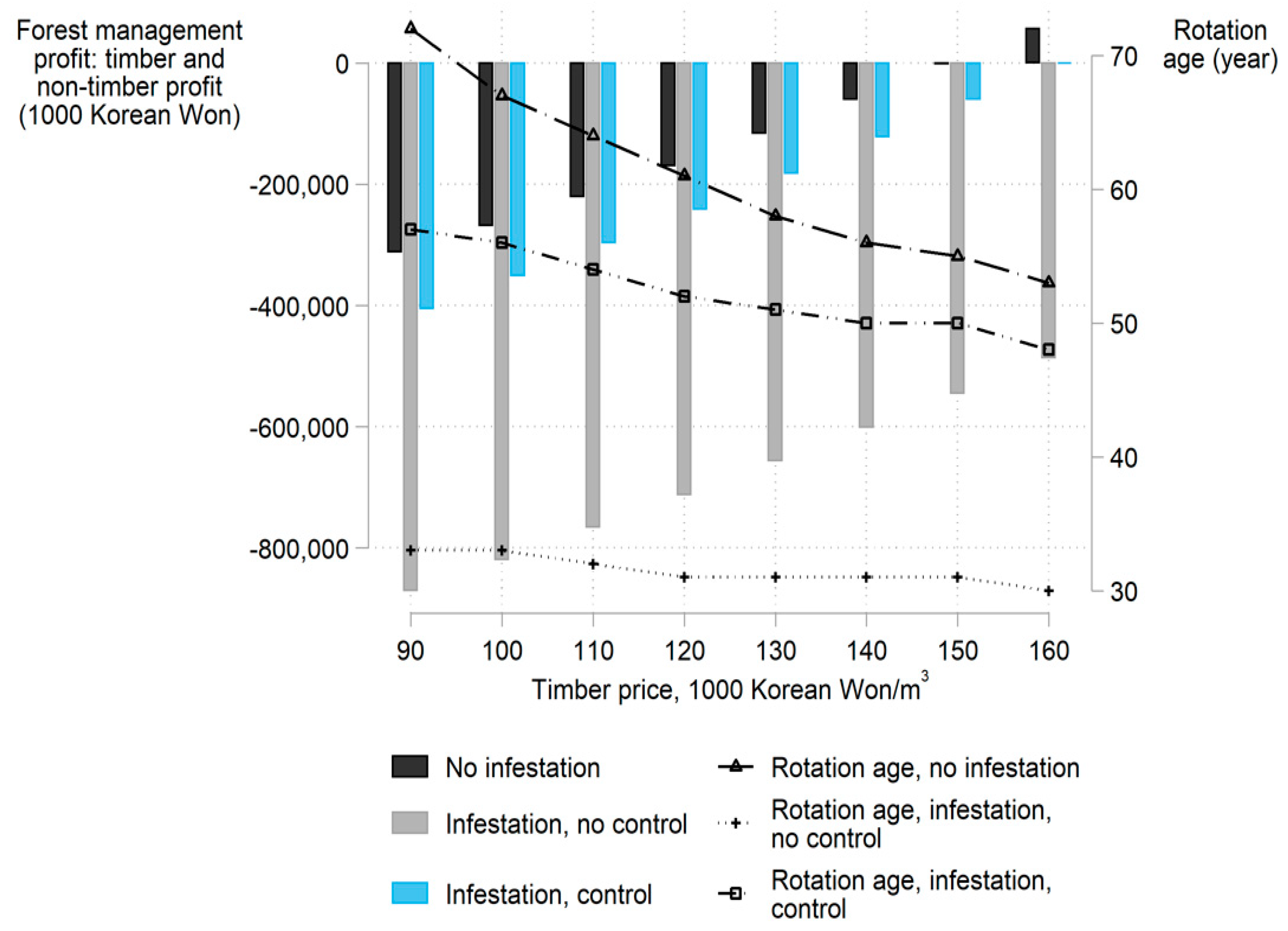
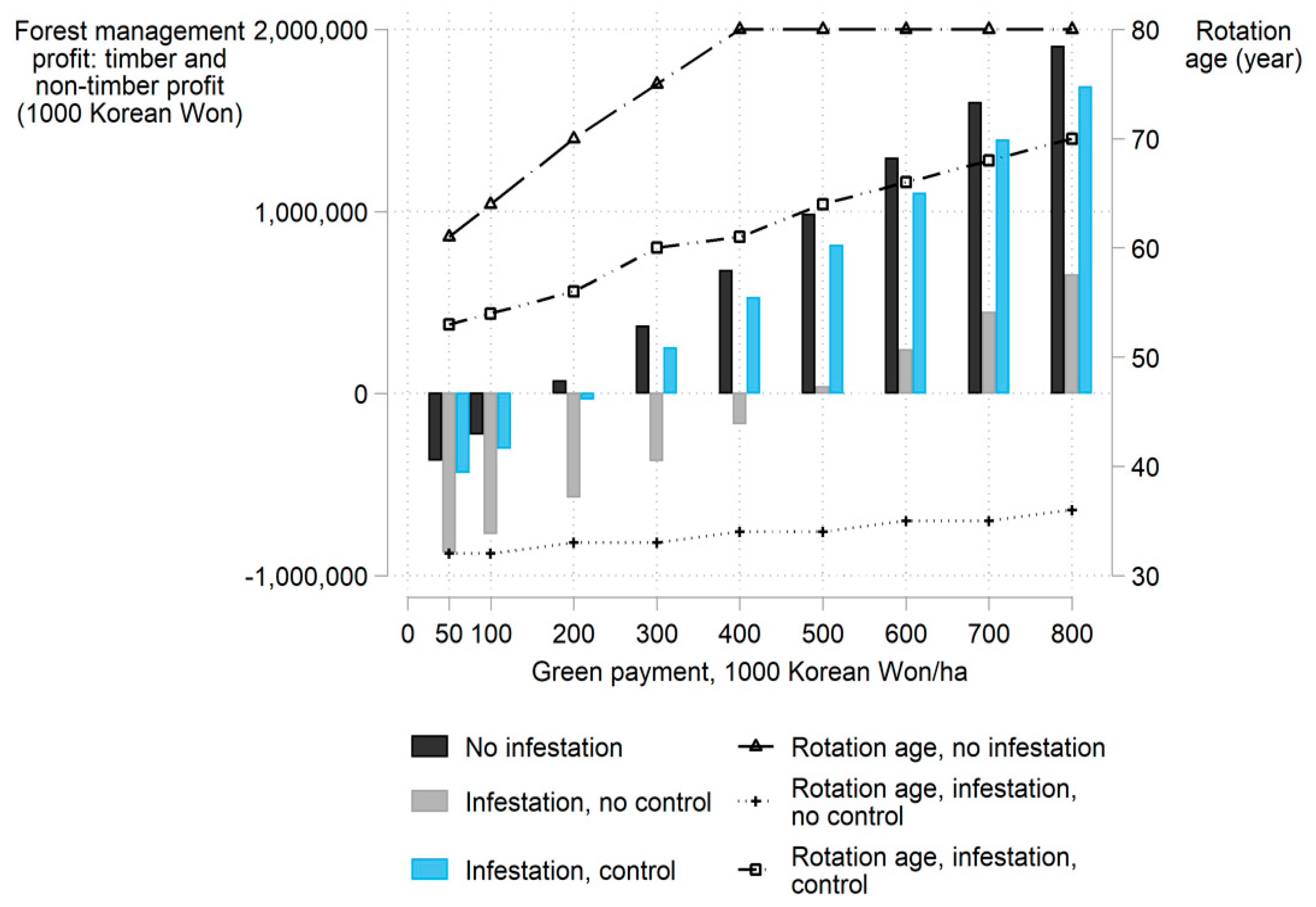
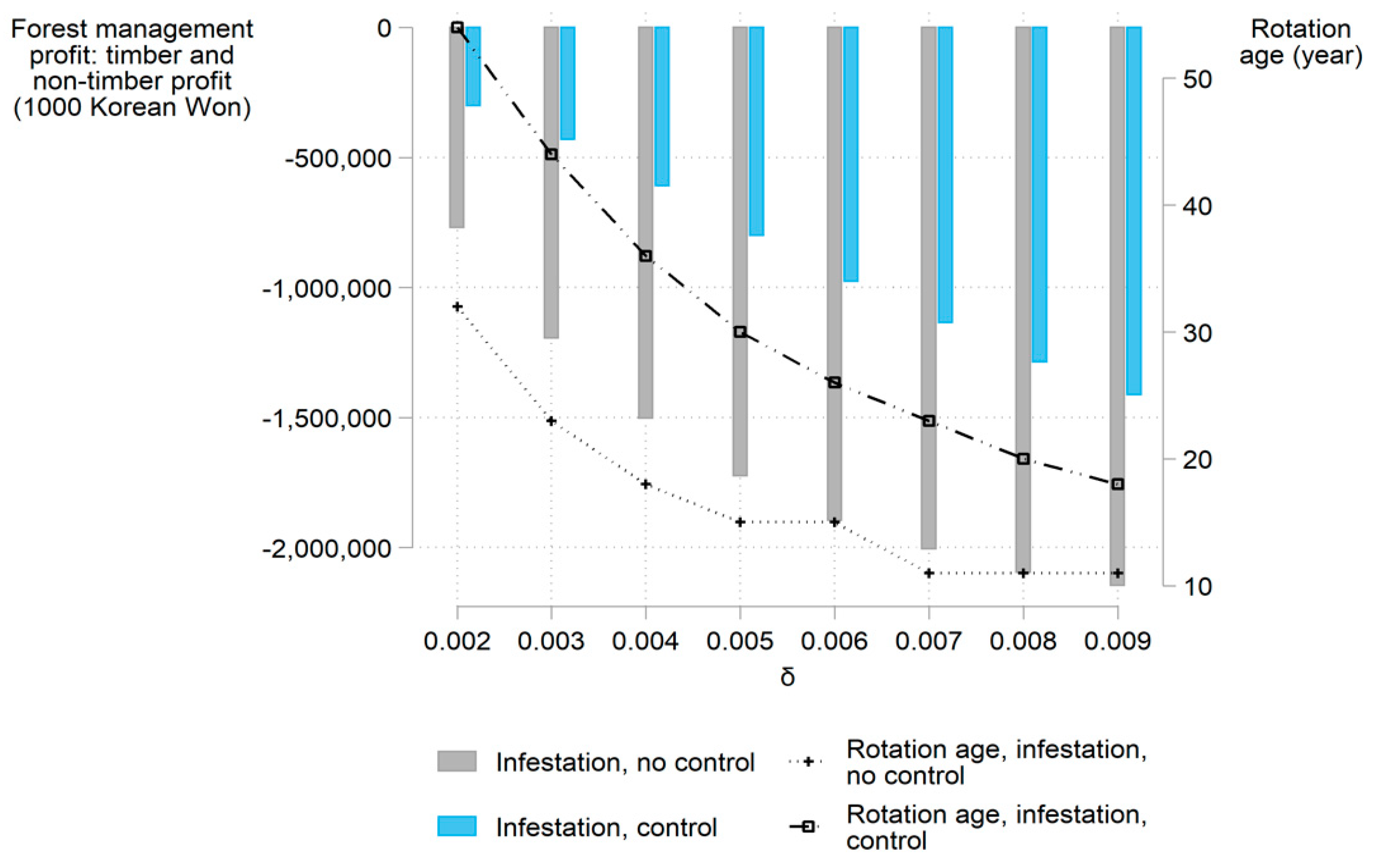
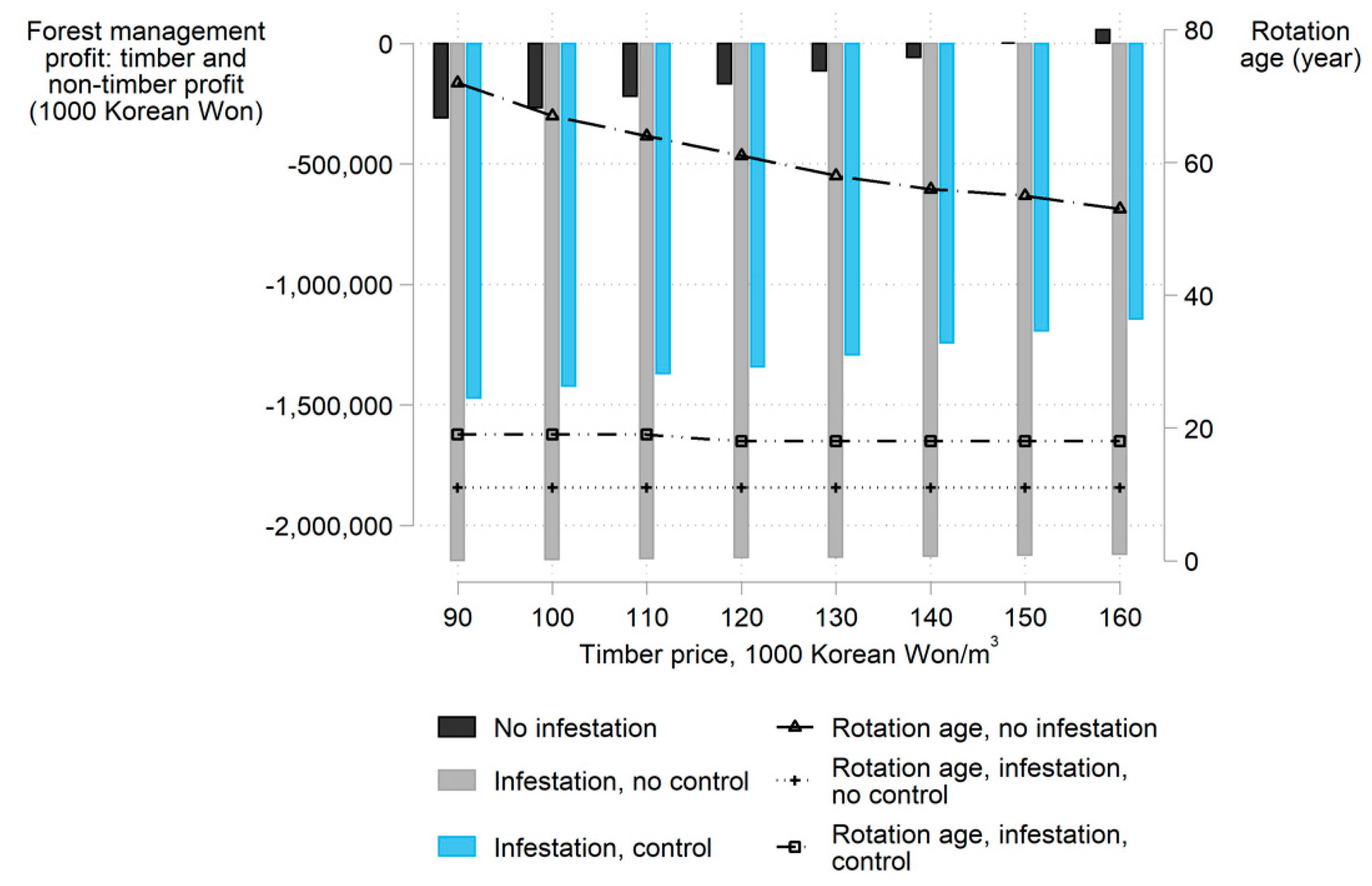
| Variable | Variable Description | Related Studies | Unit |
|---|---|---|---|
| D | Proportion of damaged area by pine wilt disease | [5] | [0,1] |
| Average minimum winter temperature | [25,26,27] | °C | |
| Average winter snow fall | [24] | Kg/m2 | |
| Average spring temperature | [15,28] | °C | |
| Average summer temperature | [15,17,26,29] | °C | |
| Square of average summer temperature | [15,17] | °C | |
| Average summer precipitation | [30] | mm | |
| Average minimum fall temperature | [26] | °C | |
| Average spring relative humidity | [18] | % | |
| Average fall relative humidity | [18] | % | |
| Population | [20] | Population unit | |
| Catastrophic dummy 1 | 1 = 2013, 0 = Other years |
| Variable | APE | Standard error 2 | p-Value |
|---|---|---|---|
| 0.00027 *** 3 | 0.00009 | 0.003 | |
| 0.00065 *** | 0.00016 | 0.000 | |
| −0.00066 *** | 0.00018 | 0.000 | |
| 0.00037 *** | 0.00014 | 0.009 | |
| 0.00018 *** | 0.00006 | 0.002 | |
| 0.000003 | 0.00004 | 0.946 | |
| −0.000006 ** | 0.000003 | 0.032 | |
| 0.00014 * | 0.00007 | 0.061 | |
| 0.002258 *** | 0.00048 | 0.000 | |
| 0.00000001 ** | 0.0000000041 | 0.011 |
| No Pest Infestation | Pest Infestation No Control | Pest Infestation | Inspection and Control | |||
|---|---|---|---|---|---|---|
| Rotation Age | Present Value | Rotation Age | Present Value | Rotation Age | Present Value | |
| Gangwon Pine | 64 | −225,283 | 32 | −771,220 | 54 | −302,395 |
| Central Pine | 55 | −308,987 | 32 | −810,831 | 49 | −422,267 |
| Korean Pine | 80 | −334,826 | 34 | −919,456 | 61 | −444,521 |
| Period | 2011–2040 | 2041–2070 | 2071–2100 |
|---|---|---|---|
| δ | 0.0031 | 0.0046 | 0.0088 |
© 2019 by the authors. Licensee MDPI, Basel, Switzerland. This article is an open access article distributed under the terms and conditions of the Creative Commons Attribution (CC BY) license (http://creativecommons.org/licenses/by/4.0/).
Share and Cite
An, H.; Lee, S.; Cho, S.J. The Effects of Climate Change on Pine Wilt Disease in South Korea: Challenges and Prospects. Forests 2019, 10, 486. https://doi.org/10.3390/f10060486
An H, Lee S, Cho SJ. The Effects of Climate Change on Pine Wilt Disease in South Korea: Challenges and Prospects. Forests. 2019; 10(6):486. https://doi.org/10.3390/f10060486
Chicago/Turabian StyleAn, Hyunjin, Sangmin Lee, and Sung Ju Cho. 2019. "The Effects of Climate Change on Pine Wilt Disease in South Korea: Challenges and Prospects" Forests 10, no. 6: 486. https://doi.org/10.3390/f10060486
APA StyleAn, H., Lee, S., & Cho, S. J. (2019). The Effects of Climate Change on Pine Wilt Disease in South Korea: Challenges and Prospects. Forests, 10(6), 486. https://doi.org/10.3390/f10060486






